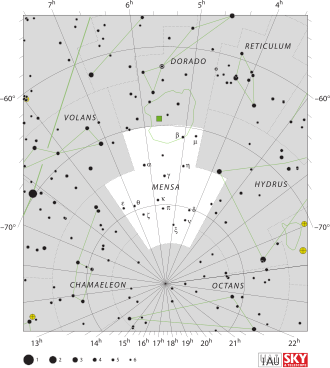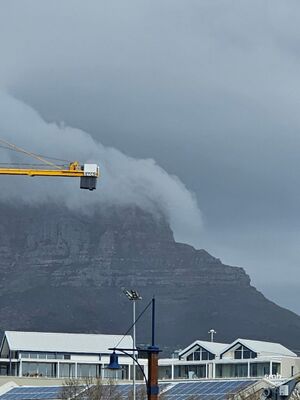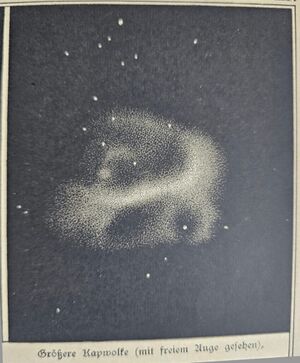Mensa
Mensa, originally "Mons Mensae" (Table Mountain) is one of the 88 IAU constellations. There were no ancient (Roman, Greek or Babylonian) constellations in this area, so early modern astronomers created names in the southern hemisphere. The region has no bright stars, α Mensae 5.1 mag, and has thus not been subject to any gestalt-seeing.
Etymology and History
In the 1750s, the French surveyor and mathematician Nicolas-Louis de Lacaille was based in the trade station at the South African Cape of Good Hope that has developed to the city of Cape Town. He lived there for two years and measured positions of the land and the stars. In gaps of historical constellations, he invented new ones and named them after contemporary devices like drawing tools, telescope, microscope, pendulum clock. The constellation of the table mountain seem to stand out as it is name after a geographical feature in the Cape Townian landscape profile. However, Lacaille's reason is preserved in his 1756 report for the French Academy of Science.
Enfin, j’ai mis au dessous du grand nuage la Montagne de la Table, célèbre au cap de Bonne-espérance par sa figure de table, et principalement par un nuage blanc qui la vient couvrir en forme de nappe à l’approche d’un vent violent de sud-est; d’ailleurs la pluspart des Navigateurs appellent nuages du Cap, ce que nous appelons nuées de Magellan, ou le grand et le petit nuage.
English
Finally, I have placed below the large cloud the Table Mountain, famous at the Cape of Good Hope for its table-like shape, and mainly for a white cloud which covers it in the form of a tablecloth when a strong south-easterly wind approaches; moreover, most navigators call the Cape clouds what we call Magellan's clouds, or the large and small clouds.
There are two easily recognisable, free-standing dwarf galaxies in the southern sky. Today, they are generally called the Magellanic Clouds (even though there is now an initiative to ask the IAU to rename them because Magellan, as a European invader, did not always behave nicely towards the indigenous people he met - and they ended up having their own names for these celestial objects, which they were well aware of). In Lacaille's time, however, this was not yet firmly established terminology and so the Frenchman suggested that the Large Magellanic Cloud be called the ‘Cape Cloud’.
"Cape Cloud" was the term with which navigators of the ocean-going ships referred to the cloud above the Table Mountain in Cape Town. Due to a weather rule, the mountain and its cloud had an instrumental function: Lacaille quotes a weather rule of the navigators, according to which a white cloud like a tablecloth on Table Mountain, before a dangerous south-easterly wind arises.
Images of the Table Mountain
Historical Images in Star Charts
Mons Mensae in Lacaille's Map "Coelum australe stelliferum" (1763): Zurich Library
Weblinks
- Ridpath, Ian, "Star Tales: online edition".




















